Saturday, March 19, 2005
Silvered Æ antoninianus, Salonina, Rome, Göbl 544p
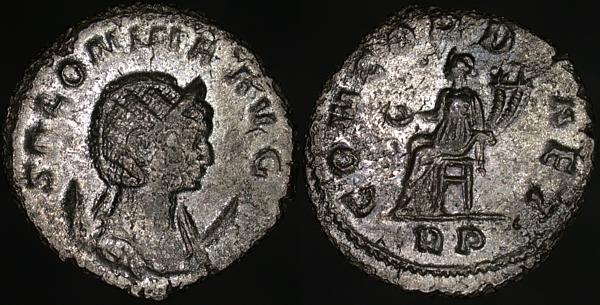
SALONINA AVG, Diademed draped bust right on crescent | CONCORD AET, Concordia seated left, holding patera left and cornucopia right. RP in exergue.
A fairly uncommon coin that experiments with what would later become the standard information in a Roman mintmark: both the mint (R) and the officina (P).
Friday, March 18, 2005
Æ32, Laerte in Cilicia, Gallienus, SNG Levante supplement 67...
(this coin)
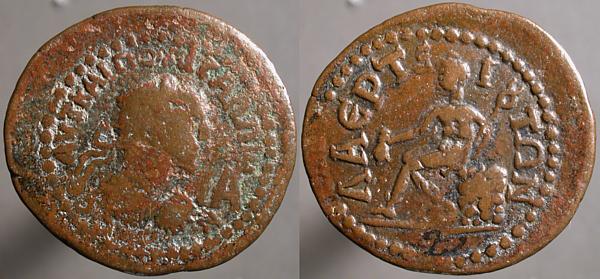
AVT KAI ΠO ΛI ΓAΛΛIH_N_O_C C, Laureate draped cuirassed bust right, IA before | ΛAEPTE_I_TΩN, Hermes seated left on rocks, holding marsupium left and cauduceus over shoulder right.
Another recent acquisition that had belonged to Eduardo Levante, this one cataloged in the Sylloge Nummorum Graecorum supplement.

AVT KAI ΠO ΛI ΓAΛΛIH_N_O_C C, Laureate draped cuirassed bust right, IA before | ΛAEPTE_I_TΩN, Hermes seated left on rocks, holding marsupium left and cauduceus over shoulder right.
Another recent acquisition that had belonged to Eduardo Levante, this one cataloged in the Sylloge Nummorum Graecorum supplement.
Thursday, March 17, 2005
Silvered Æ antoninianus, Gallienus, Rome, Göbl 712uvar...
(officina letter, placement)
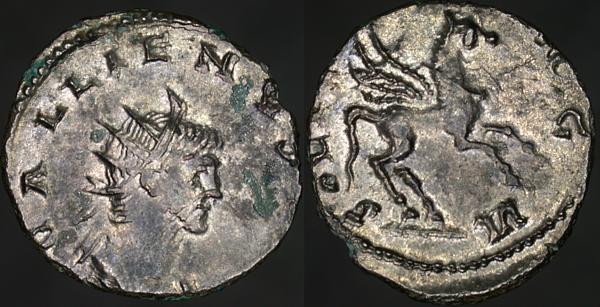
GALLIENVS AVG, Radiate cuirassed bust right | SOLI CONS AVG, Pegasus leaping right. Inverted VI to right of groundline.
I don't quite know what to make of this. Göbl doesn't attest any field mark for this reverse except for "A" in the exergue and a single example of "X" in the exergue. I've already shown this example in nice style that shows an A (or inverted V?) to the right of the groundline. A page at Jim's Virtual Coin Collection shows the like and another with "AI" to the right of the ground line.
Cohen's Description Historique des Monnaies Frappeés sous l'Empire Romain lists a VI fieldmark, and RIC, perhaps simply following Cohen, does as well.
On the other hand, this doesn't look quite like official mint product. The appearance may have been distorted by the double-strike that's evident, it still looks wrong. But this came to me fully-silvered, and it makes little sense for an ancient counterfeiter to have silvered a coin.
As I said, I don't quite know what to make of it.
Jim, of the previously mentioned Virtual Coin Collection suggests an unofficial copy modeled after a coin with a poorly-formed "A" mintmark to the right of the groundline.

GALLIENVS AVG, Radiate cuirassed bust right | SOLI CONS AVG, Pegasus leaping right. Inverted VI to right of groundline.
I don't quite know what to make of this. Göbl doesn't attest any field mark for this reverse except for "A" in the exergue and a single example of "X" in the exergue. I've already shown this example in nice style that shows an A (or inverted V?) to the right of the groundline. A page at Jim's Virtual Coin Collection shows the like and another with "AI" to the right of the ground line.
Cohen's Description Historique des Monnaies Frappeés sous l'Empire Romain lists a VI fieldmark, and RIC, perhaps simply following Cohen, does as well.
On the other hand, this doesn't look quite like official mint product. The appearance may have been distorted by the double-strike that's evident, it still looks wrong. But this came to me fully-silvered, and it makes little sense for an ancient counterfeiter to have silvered a coin.
As I said, I don't quite know what to make of it.
Jim, of the previously mentioned Virtual Coin Collection suggests an unofficial copy modeled after a coin with a poorly-formed "A" mintmark to the right of the groundline.
Wednesday, March 16, 2005
AR denarius, Maximinus I "Thrax", Rome, RIC 7A
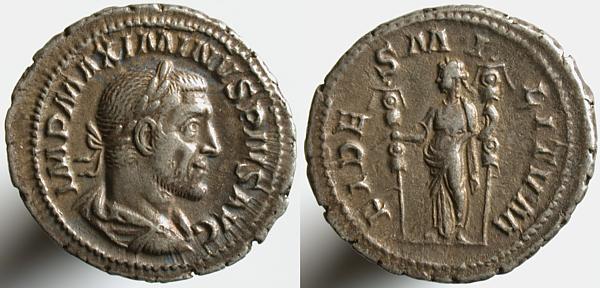
IMP MAXIMINVS PIVS AVG, Laureate draped cuirassed bust right | FIDES MILITVM, Fides standing left holding a standard on either side
Gaius Julius Verus Maximinus succeeded Severus Alexander in 235. Even among Roman emperors he stands out as particularly colorful: a soldier born of barbarous parents, over eight feet tall by some accounts, some of his coins appear to show the prognathous jaw characteristic of acromegaly.
By 238, the Senate had found allies in abused landowners in the North African colonies, and Maximinus was killed by his Praetorians after he insisted on persisting with fighting once his troops had been weakened and demoralized by the scorched-earth tactics used by the legions favoring Pupienus and Balbinus.
Tuesday, March 15, 2005
Æ30, Laerte in Cilicia, Gallienus, SNG Levante 382 (this coin)
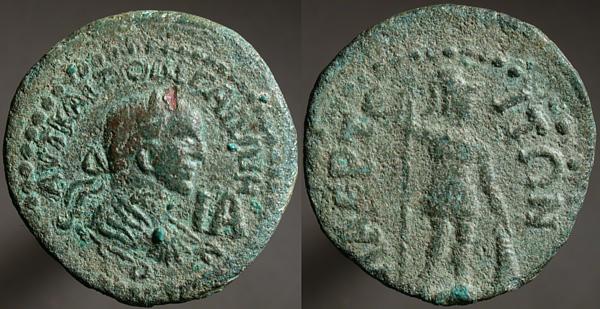
AVT KAI ΠO ΛI ΓAΛΛIH_N_O[?], Laureate draped cuirassed bust right, IA before | ΛAEPTE_ITΩN, Ares standing facing, head right, holding spear left and shield on ground right.
The extensive collection of Eduardo Levante of Cilician coins, cataloged in a volume of Sylloge Nummorum Graecorum, went on the market a few years ago, and they haven't all settled into collections yet, continuing to be sold between dealers, again and again until each finds its natural customer. I bought a few two years ago and find myself buying a few more this month.
Monday, March 14, 2005
Æ antoninianus, Gallienus, Rome, Göbl 372p
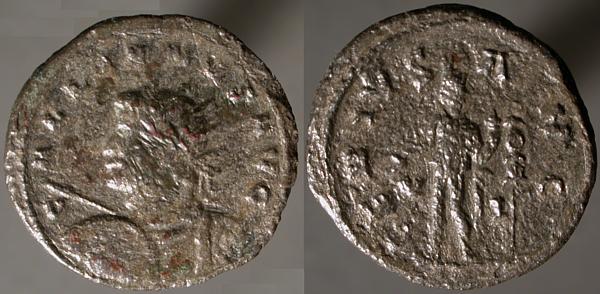
GALLIENVS AVG, Radiate cuirassed bust left, holding shield and spear before | GENIVS AVG, Genius standing facing, head left, holding cornucopia right and patera left. Standard right. V in left field, I in right.
The reverse shows the Genius, or tutelary spirit, of Gallienus. Rome minted a number of minor variations of this reverse, showing the Genius beside a standard, and Antioch minted an entirely civilian GENIVS AVG coin with a legend that wandered a bit, with GENIV AVG and GENIO AVG examples not unusually difficult to locate.
Sunday, March 13, 2005
Æ30, Mopsuestia-Mopsus in Cilicia, Valerian, SNG Switzerland 1359
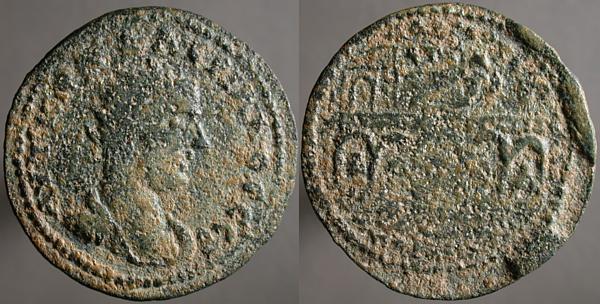
AVT K [...]IANOC CEB, Radiate cuirassed bust right | [...], Bridge.
I wish I had a copy of SNG Switzerland (aka SNG Levante, I just learned they're the same book) or, of course, a finer example of this coin. As it is, it's more intriguing than illuminating. I'd really like a good look at what that reverse is showing and what's on that bridge.

